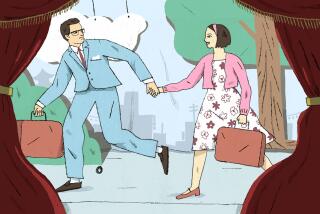‘Sincerely yours, Harper Lee’: A reclusive author’s words to a faithful high school teacher
If 10th-graders took Luciano DiNardo’s high school English class, it was a sure bet they were going to read “To Kill a Mockingbird,” Harper Lee’s classic novel about racial injustice in rural Alabama.
DiNardo also gave them assignments to write about civil rights and prejudice. He showed them such classic films as “Mississippi Burning,” to provide them with the history of racial segregation in the Deep South.
DiNardo always wondered whether Lee knew how much her words meant to young teenagers in faraway Canada. One day, in 2007, he decided to let her know. He mailed her a two-page typewritten letter, telling her about all the things that had happened to her book in the hands of teenagers in Canada.
See more of our top stories on Facebook >>
Based on his assignments, he said, some had written new endings for the book, imagining what might have happened to Scout when she grew up. Others wrote subplots, or prequels imagining how Atticus Finch had met his wife. (Only later, with the publication in 2015 of Lee’s “Go Set a Watchman,” would DiNardo learn that Lee had penned alternative scenes for her characters.)
He hardly hoped for a response.
“I told teachers at the school what I did and they all thought I was crazy,” said DiNardo, a married father of two sons who lives in the east Ottawa suburb of Orleans. “They said there was no way she was going to write back to an English teacher in Canada.”
They were wrong.
That same month, DiNardo received a reply from Lee, handwritten on paper monogrammed with the initials NLH (her first name was Nelle) and sent from her hometown in Monroeville, Ala.
She wrote that his letter “brought much joy to my heart,” that it was “humbling” to know that “TKAM” (as Lee abbreviated the book title) was being taught in schools.
“I should be forever grateful just for that, but your imaginative use of it really makes me indebted to you for the rest of my days,” Lee continued on the other side of the page. “Your gifts as a teacher should be proclaimed throughout the land.”
She signed it, “Sincerely yours, Harper Lee.”
DiNardo, who retired in 2010 after a 28-year teaching career, said he was “surprised” when he received the letter from the reclusive author; he figured she must have been “intrigued” by fan mail from as far away as Canada.
He was content to leave it at that; he wasn’t going to write her back.
“I didn’t want her to think, ‘This guy is getting in touch with me because he wants a literary connection,’ and just wanted her to know that teachers have benefited wildly from her timeless work,” DiNardo explained.
It was also only the second time he contacted the author of a book.
About 18 months later, DiNardo was getting ready to replace his well-worn copy of the book. Its spine was cracked, its pages either filled with underlined passages and notations or falling apart.
He was transcribing his notes from the old copy into the new one, which he was going to throw away, when he had an idea.
“All of a sudden, I thought, how about I bubble-wrap it and mail it to Harper Lee with a short note telling her this is evidence of what her novel meant to me, and all the work I was able to do with it in the classroom,” he said.
In less than two weeks, DiNardo received a reply.
This time the letter was shorter and the penmanship shakier, which could have been the result of a stroke she had suffered the previous June.
Lee thanked DiNardo for sending her his copy of the book and wrote that she “enjoyed seeing what the students have done with it.” She praised his classroom notes about assignments and essays, written inside the book, as “most creative.”
“My vision is very poor now, but I have had no trouble reading your kind letters. Sincerely yours, Harper Lee.”
The second reply left DiNardo “stunned.” But it also gave him an opportunity to show his students words handwritten by the author of a novel that has sold more than 40 million copies worldwide.
DiNardo keeps both letters, wrapped in plastic and sealed with Scotch tape, in a filing cabinet in his home office.
See the most-read stories this hour >>
“Occasionally some people want to handle them, so if they were in a frame, I couldn’t let people do that,” he explained.
There will be no more letters. Lee died last week at age 89. And DiNardo has retired from his high school teaching job.
But he likes to think that his brief correspondence with Lee helped inspire his new career as a novelist.
His first book, “The Angel’s Kissing Spring,” launched last week, is set in a small town in an unnamed northern U.S. state in 1942. It features a “disreputable” young woman whose 3-year-old son is found dead in a neighbor’s well. She spends the next three years visiting her son’s grave, and one day meets a homeless man sleeping near the tombstone and begins a relationship with him.
DiNardo said he wouldn’t have sent Lee a copy of the novel; it contains sexually explicit material that could have offended her “sensibilities.”
However, he might have shared with her a literary nod he inadvertently made to “To Kill a Mockingbird” in his novel.
Lee’s novel spotlights the hypocrisy of a group of women in a missionary circle who raise money to help poor blacks in Africa but who also have racist views about blacks in their own community of Maycomb, Ala. DiNardo’s book depicts the duplicity of women in a ladies’ auxiliary who show disdain toward his protagonist, yet seek to engage in charitable work.
“When I finished that chapter, it seemed similar to the missionary circle in Harper Lee’s book,” DiNardo explained.
“But it was subconscious. Something inside me was at play there.”
Guly is a special correspondent.
MORE ON HARPER LEE
Rare Harper Lee audio interview unveiled by UCLA
Author Harper Lee quietly buried in her Alabama hometown after private funeral
Harper Lee was my David Bowie: How ‘Mockingbird’ changed one writer’s life
More to Read
Start your day right
Sign up for Essential California for news, features and recommendations from the L.A. Times and beyond in your inbox six days a week.
You may occasionally receive promotional content from the Los Angeles Times.






